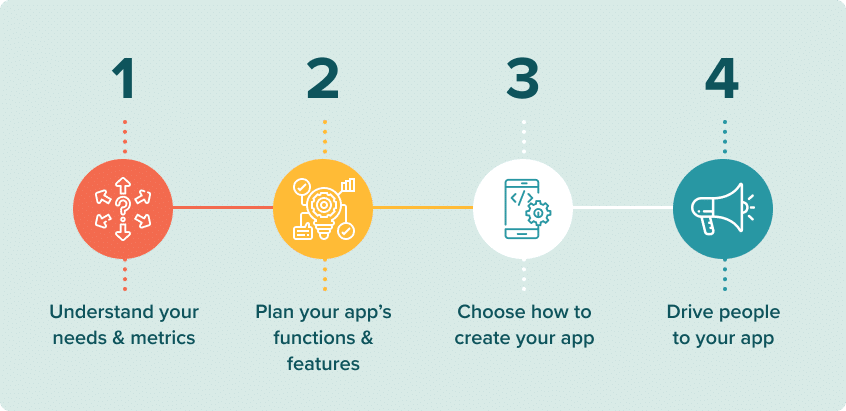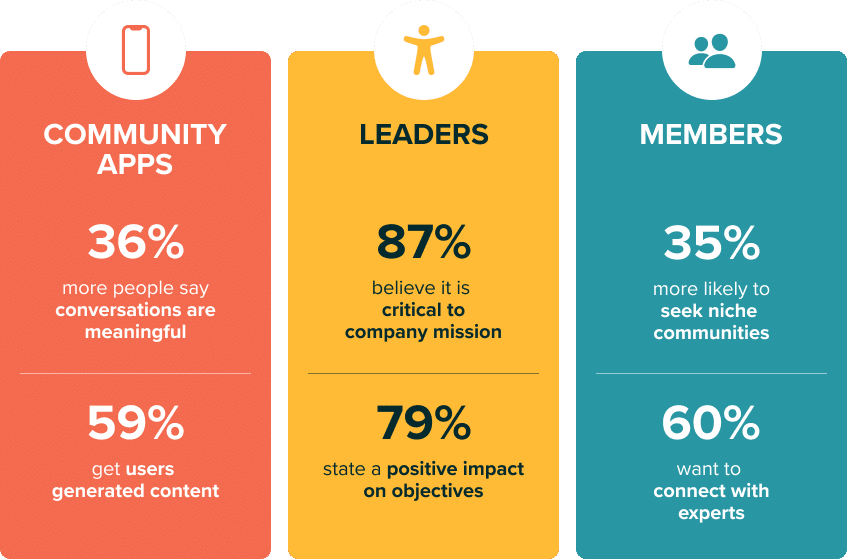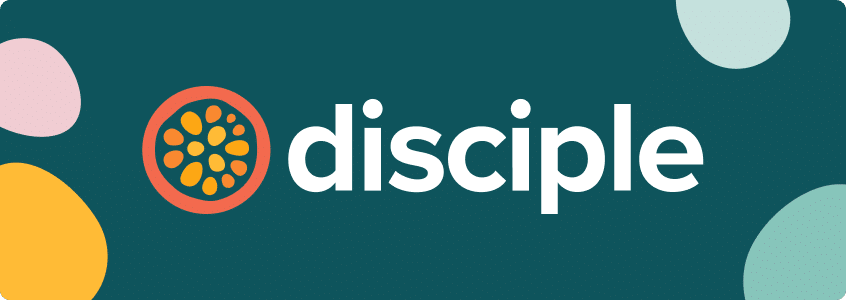How to make a social media app for your business and create a thriving online community
- 06/05/2022
How to make a social media app for your business and create a thriving online community
- 06/05/2022
To social or not to social? That’s the question facing creators, business leaders and community managers in 2022. Do you fall in line with Facebook and create an online community bound by someone else’s rules and algorithm? Or do you say no and instead build your own social media app? Private. Branded. Exclusive.
Stick with us in this beginner’s guide and learn how to make a social media platform from scratch – without needing to know how to code an app or develop a website.
We’ll show you how to create a good social media site instead of one that drains people. How to start a network that starts a movement. How to make an app like Twitter, Instagram or even Facebook, but with the added bonus of monetisation, customisation and complete independent ownership.
How to make a social media app

Why should you create your own social media app?
It’s easy to get caught up in the dream of having your own app – a mini portal to you and your community, out there in App Stores and pockets far and wide – but will it be worth it in reality? Do apps actually work to make lasting connections, bring in business, inspire action or growth or meaning?
In case you need to make a solid business case to sell the app idea up the chain, let’s first take a look at the cold, hard facts. (Spoiler alert: everything’s coming up roses!)
Or if you’d prefer to get straight into the how-to, skip ahead to Step One.

When you own the platform, all the data is yours. You can tell exactly how people are interacting, what’s working, what they’re stuck on. And you can do it without a snooping tech CEO or limited analytics dashboard getting in the way.
It’s easier to ask questions directly too. Responding to a poll by CMX, 65% of community managers said they get valuable product feedback from their community. 34% have even hosted customer advisory boards to really get a feel for what their members want, need, think and feel. What might you ask about?
60% of people say they use social media to connect with experts and ask questions on specific topics. But whereas many people are put off by the lack of privacy on traditional social media, creating your own app can make all the difference.
Compared to traditional platforms, people see custom online communities as places to open up and truly be themselves. According to research by Reddit, 36% more people think the conversations are meaningful; 28% more think the atmosphere is respectful; and 19% more think their voice gets heard.
And if you happen to represent a niche interest group, you could be looking at even more engaged members. Social media users with uncommon interests are 35% more likely to go online to make connections.
With a customised community app, you create an environment where so much more is possible. You can give members access to features and tools they don’t see on social media. You can host collaborative livestreams. You can start creative challenges, trends and activities. All in a safe space for members that’s free from judgement and hassle.
Responding to a poll by CMX about what their members contribute, 59% of community managers mentioned user-generated articles and content; 36% speak of member-hosted events; and 11% even have members creating tools and applications for people to share. With the right tools, encouragement and space, the only limit is the imagination.
Commission… Platform fees… Juggling four services to take a single payment… Sound familiar? Running a business online can be admin-heavy and a logistical nightmare as you expand, but it doesn’t have to be.
If you work with the right software provider or app-building partner, you can create an app that lets you monetise your community and manage everything in one place – from taking payments and subscriptions to connecting members and carrying out your service.
One of the communities we helped to build now sees 90% of their business come through their app. And they aren’t alone. Across the world, 79% of community managers believe their community has had a positive impact on their company’s objectives, and 87% believe it’s critical to the company mission.
Since Covid-19 arrived, people have spent an average of 43% more time on social media apps, but not the ones you might think. Independent social media apps and online communities are on the rise. And although Facebook does still hold the top spot, engagement on the platform hardly compares.
Leaders of communities that are based in Facebook Groups report their posts reaching as little as 2% of their members. Compare this with the communities we’ve created apps for and it starts to get interesting. Typically, around half a community’s members engage every month, and our top-performing customers reach a staggering 75% monthly active members. Thanks to features like push notifications and in-app nudges, leaders are able to reach members whenever and wherever they are, away from the usual noise. It just makes sense.
Step One: Understand what your community app needs and set your metrics for success
What is the purpose of your social media app?
For people to download your app, it has to give them a good reason to invest their time and attention. It has to give them something they need – whether they know they need it yet or not.
What does your target audience need? Think beyond what you sell or provide. Or rather, think around it. For example, if your business sells bathroom tiles, your customers might also need DIY tutorials, tool recommendations, design inspiration, a place to show off their work, and so on.

- What might your target audience need that you could provide, create or facilitate?
- What experiences could you provide them that add value?
- What types of social interactions could you support?
- Why might your target audience come to you over a competitor?
- What do you both value, believe or hope for?
- Which areas of a person’s daily life do you impact?
- How do your target audience interact with each other on social media?
- How could purpose-built features make each interaction better?
Remember, your audience may not know they have a need until they see there’s an app for it – an opportunity for you to get creative and show them what they’re missing!
How will you measure the success of your social media app?

By now, you should have a good idea of what your community needs. What about you?
Are you hoping your social media app will bring in stronger leads and extra revenue, gather cost-effective insights and feedback, boost engagement and retention?
Do you want to get to know customers on a more personal basis, build awareness and advocacy of your brand or mission, reach further to connect more people?
Now’s the time to set some rough goals that will help keep your eyes on the prize. Many of these you will be able to measure with ease through your social media app. Being purpose-built and privately owned, there’s nothing to stand between you and your data.
Common success metrics for a social media app
To get you started, here are some of the most practical and commonly used metrics that community leader and app builders use to measure success.
CPI (Cost Per Install)
Average cost of an advert that leads to a download
CAC (Customer Acquisition Cost)
Overall marketing cost of acquiring a member
User Activation
Percentage of members who are active
User Retention
Percentage of members who keep using your app
User Churn
Percentage of members who stop using your app
User Engagement
Measurements related to number of actions, time spent or frequency of visits
Understanding your Analytics
- Video explanation of your Analytics dashboard
Step Two: Plan how your social media app will work and choose which features to include
Here we start to get into the nuts and bolts (or taps and swipes) of how people will use your app in real life. Phone in hand, App Store download complete, what will they see and do?
If you made notes on our earlier questions about what your target audience needs from your community and how your app could provide it, they’ll be useful now. Keep them in mind as we consider some of the functions and features that become available when you create your own social media app. Think about how you might apply, tweak or combine each feature to fit your audience and create their ideal experience.
1. Community Structure
Navigation dictates how people will use your app, making it one of the most important parts to plan. And although it may seem logical to choose your features before you decide how to join them up, a general idea of layout can help you get started. So…
What will be the main purpose or function of your app? What should people see first, big and bold? The rest can flow from there through menus and folders.
Social media apps tend to open with an activity feed that displays recent posts and comments. Is this what you want to do? If so, you could open to a general feed, one for a specific group, from yourself, from members’ friends, or so on. Maybe you only want certain people to be able to post to the feed, or maybe it’s open to all. What makes the most sense for your community?
If you would prefer for members to get straight into your specialist content, you could open to a resource library and build the app around that. Comments and feeds are still an option, but members would find them elsewhere or access them through the app’s menu. Communities built around learning and sensitive information often choose this option.
You can mix and match the features in all these options, but if your social media app will primarily be used for live streaming and calendar events, you might want to put those front and centre. Then you can think about how polls and comments might work, and how push notifications can help make sure every member turns up and keeps turning up.
Disciple Features
- Find out about all the features of our app
2. Member connections
Online communities that last make human connection effortless. Facebook, Instagram and all the rest know this, and members will expect the same from your private social media app. How you go about it, on the other hand, is up to you.
The foundation of a member’s online identity, a personal profile does more than just put a face to a name. It enables users to decide for themselves who they are and how they want to be seen within the context of your community, and provides a way to search for people like them, add them as a friend and make lasting connections.
Each community is of course different, so profiles should reflect this by including relevant fields. A golfing community might want to include handicap, for example. A weight training community could include targets and wins. You could even create badges to celebrate them.
A key benefit of building your own social media app is the potential for groups and sub-groups. As we discussed earlier, people are more likely to seek you out and stick around if you serve their particular niche interest within your wider area of expertise. Alternatively, you could set up secret or private groups for particular members.
Traditional social media generally restricts your ability to divide up your community, so how might you use sub-groups to help them find their people and flourish? Perhaps our bathroom tile community could have a floral tile designs sub-group, or a sustainable grouting techniques sub-group, for example.
Do you want to let people talk among themselves privately or keep it to the comments sections? Can anyone message anyone, or only their friends? Generally, it’s a good idea to open things up and give people plenty of ways to chat, but you don’t have to. If your priorities are privacy or protecting vulnerable members, you could cut out the messaging altogether or request verifications first. But remember, members will want to connect with each other as well as with you. So how will you help them do it?
3. Resource library
Keep your content in one central location that’s reliable, organised and owned by you. Make it available to members whenever they want it, wherever they are. And decide who sees what with full control over permissions and privacy.
You could show off photos, videos and other visual content – both yours and your members’ – in a stylised and interactive gallery. Allow members to contribute user-generated content with ease, or organise your own work, designs and products.
Sounds dull, but don’t underestimate the value of being able to organise your content according to your own logic. Folders and lists give you the freedom to set out your content exactly the way you want to. You can create a direct route that makes sense for your community instead of having to make them scroll through feeds and albums to get what they need.
Do you want to let people talk among themselves privately or keep it to the comments sections? Can anyone message anyone, or only their friends? Generally, it’s a good idea to open things up and give people plenty of ways to chat, but you don’t have to. If your priorities are privacy or protecting vulnerable members, you could cut out the messaging altogether or request verifications first. But remember, members will want to connect with each other as well as with you. So how will you help them do it?
4. Moderation tools
Just because a community is thriving doesn’t mean every single person will get on with each other. Despite having escaped the trolls and abuse that often comes with traditional social media, sometimes you may still have to step in. It pays to be prepared, so consider how you might use moderation tools.
You could allow people to block other members and report their behaviour to admins. You could impose shadowbans on offenders, disable their posts, or delete them. You could raise trusted members to the rank of admin or moderator and share the load with them. As leader, it’s your responsibility to have this covered. Thankfully, with your own app, it becomes much easier and more intuitive.

5. Livestreaming and RTMP

Thanks in part to lockdown Zoom culture, face-to-face contact online has become the norm. But you can do it even better!
Built directly into your app, meaning you don’t have to send members on jaunts around the internet, you can create a highly personal experience with minimal effort. And now that HD quality video with flexible RTMP is available, purpose-buit apps leave the competition in the dust. How might you use livestreaming?
Learn more about livestreaming
- How might you use livestreaming?
6. Customisation
and branding
The finishing touch of a private social media app, and what helps set it apart as special and unique, is the branding.
It’s also what ties your app to the rest of your business, cements your identity, and makes you instantly recognisable. Make sure to customise your app by including your logo and brand colours to really make it pop.

7. Security

We’re all aware that online security is vital, but what can you actually do about it? As the leader of a community you need to be in control, so you need to have an answer.
On traditional platforms, you don’t have much say over where your and your members’ data goes, or who owns what they post, or who can stick their noses in. It’s a different story when you create an app for your business your own way. Your app is hosted independently, your information is private and protected, your rules are your own. Security systems are largely automated so we won’t spend much time on it here, but if you’d like to then you can find out more about security here.
Learn more about security
- Security at Disciple
8. Analytics
Remember the metrics we discussed in Step One to help you measure success? Something to consider now is how you will access them. If you’re already used to using Insights on Facebook or Instagram, that’s a good way of visualising the basics. If not, don’t worry – you’ll be creating a social media app that does all the legwork for you.
The way we do it for our customers is to pull your stats and insights into a single dashboard that’s crystal clear and super easy to navigate. At a glance you can see how many members were active today or this month, how often they each came back, which devices they used and what activities they took part in. And that’s only scratching the surface.

9. Monetisation
You do a wonderful thing for people when you create a community and invest in a social media app. The sense of belonging, purpose and connection can be life-changing for members.
And there’s absolutely no harm in making an honest living from the service you provide. It’s worth noting that the App Stores charge a 30% fee on app-related income, but you won’t have to pay commission to any third parties. So what are your options?
There are three main subscription models: free, freemium and premium. Free costs members nothing at all. Freemium costs nothing to download the app but certain features and content are locked away until you subscribe. Premium means the only way for a member to access the community and app is by paying a monthly membership or subscription fee.
Like a Premium subscription model, members only get access by paying for it. Unlike a subscription model, members only have to pay once. Download the app for a price, get everything inside. Or almost everything…
Would one-off sales make sense for your business? You can use in-app purchases instead of or as well as subscriptions to your social media app, giving you flexibility to build a business model that works for you. In-app purchases are generally thought of as digital goods you would deliver through your app, like a series of videos or access to a course.
You can use your app as a shopfront for real-world goods as well as digital ones. Though still purchased through the app, like an in-app purchase, these are referred to as physical purchases. Can you guess what our bathroom tiling community might sell?
A great way to introduce new revenue streams without adding too much to your workload, you could allow other organisations, brands or partners to sponsor certain areas of the app or pieces of content. They pay for the honour of including their name, logo or original content in your space because they want to be associated with your brand or gain access to the people you’ve brought together.
You could also host ads if you want to, but they can negatively impact customer experience and App Store ratings. Sponsorships are far a safer bet if you can get them.
Exclusive meet and greets, live streamed conferences, a series of seminars, or even something hosted in real life. If you can give your community premium experiences that are genuinely meaningful or helpful, they may be willing to part with a little extra cash. Why not earn a penny for your thoughts?
Step Three: Choose how to create your social media app
Can you picture it yet? Now that you’ve done your research and planning, it’s time for the fun part… building! But what’s the best way to do it? When it comes to creating your own independent, customised and branded social media app, you have four options.
4 ways to create your social media app
SaaS platforms such as Disciple provide you with out-of-the-box features to choose, combine and customise. Using a suite of simple tools and help if you need it, you can build a professional-standard social media app. One that appears in App Stores, is fully responsive for web and mobile, and takes little to no technical skill to manage.
All the features we mentioned in Step Two are available when you choose a SaaS platform, from branding and livestreaming to monetisation and analytics.
Open-source software can be downloaded and configured on your own server. There are both free and paid options available, ranging from sites like Reddit to more flexible options. To customise open-source software, you’ll need to have a developer on your team or hire one to build and maintain your site.
If you were to hire a developer, you could access all the features we mentioned in Step Two. However, you wouldn’t get automatic software updates, would have to pay additional hosting costs, and wouldn’t benefit from customer support.
CMS (content management system) platforms like WordPress or Drupal could, through the use of additional plug-in software, be used to build a social media site. Many of these plugins can be found for free, but there are limits to what they can achieve and are notoriously buggy.
With this option, you could build a social media website rather than an app. It could use some of the features we mentioned in Step Two, but they would have to be low-quality versions that provide a fairly lacklustre experience.
Let’s say you have a completely unique idea that requires extremely advanced technology, like a Snapchat-style social media app that has VR filters. The only way to build your innovative new app would be to hire a specialist app development company.
This is not an option we recommend unless your business is particularly gargantuan and established, being an incredibly expensive and time-consuming process.
Disciple’s recommendation

We want to help you choose the most suitable option for your business and community, so we’re laying out the facts and leaving it to you. That being said, we know who we’d pick…
Choose to work with Disciple, using our SaaS platform to build your social media app, and you get access to everything we’ve mentioned in this guide. To top it off, here are a few more reasons:
A great way to make people feel at ease with sharing is to give express permission – create a ‘Photos Thursday’ or ‘Sunday Reflections’ ritual where everyone is invited to share, comment and connect without judgement.
- You can integrate your existing tools, from Mailchimp to Salesforce
- You get as much technical and strategic support as you need
- You join a collective of community leaders who help each other thrive
A new era for community builders
- Discover how Disciple can help you
Step Four: Drive people to your app
You’ve made it! If you’ve followed all the steps so far, by this point you should have a fully functioning, purpose-built social media app, as well as a plan to measure your success metrics and monetise your offer. Now you just need to migrate your community from where you previously gathered, and start to attract new members.
Start with a migration program
If you already had a community growing somewhere, such as a Facebook or LinkedIn Group, these are the first people you should direct to your new app. Ideally, you should start telling them about the move a month or so before the app is ready to get them used to the idea and excited for what’s to come. Make sure to keep them informed and inspired – after all, they get the first look at your new space. And who doesn’t love an exclusive?
Migration programs shouldn’t be underestimated. Get it right and your social media app will be off to a flying start. Get it wrong by leaving it to the last minute and you could do yourself a disservice. But never fear, we have a full guide full of migration program tips and tricks here.
How to migrate your community
- 6 simple steps to migrating
Simple ways to attract new members
Assuming you have a website, create banners that show off your new app and direct people to download it. When your website’s visitors click the banner, they should be taken to your App Store page to download the app.
Already sending out newsletters or email updates? If so, use them to push your app through featured blogs, infographics and videos. If you don’t already send anything to your members, now’s the time to start. Whatever you create, remember to always include a strong call to action to download the app.
Google Ads are a great way to get your content in front of new, relevant audiences. You tell the algorithm who you want to find, set your budget, upload your content, and let it roll. You can do the same with most social media sites.
Put your members to work! Once they’ve joined and settled in, prompt them to invite friends by sharing a referral code. Try to make it as easy for your members as possible – an easy-to-find link they can simply copy and paste, attached to a feelgood message that motivates them to share far and wide.
Final words
Tada! And that, my community-building friend, is how you create a social media app from scratch. It’s one of the most satisfying projects and savvy decisions you can make for a business in 2022. Free from the rules and whims of Big Tech, you’re doing it your way. And your community will love you for it.
Remember to fully embrace your niche, empower others to find theirs, and if you can make a few bob along the way then more power to you.
And if you’re sitting there thinking “this is going to cost a fortune and take ages”, think again. Some of our customers have had their apps up and running in two weeks, others two months. We move at your pace, towards your goals. And with our flexible, fair and honest pricing model, you know exactly what’s coming. So… fancy a look?
Are you looking to grow, engage with
and monetise your own community?
Are you looking to grow, engage with and monetise your own community?
Create your very own community platform, on Web, iOS and Android. Gather, engage and
profit from your community in a safe space that you control. Your community, your rules.




